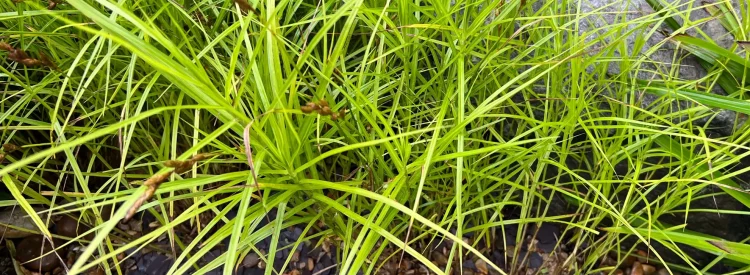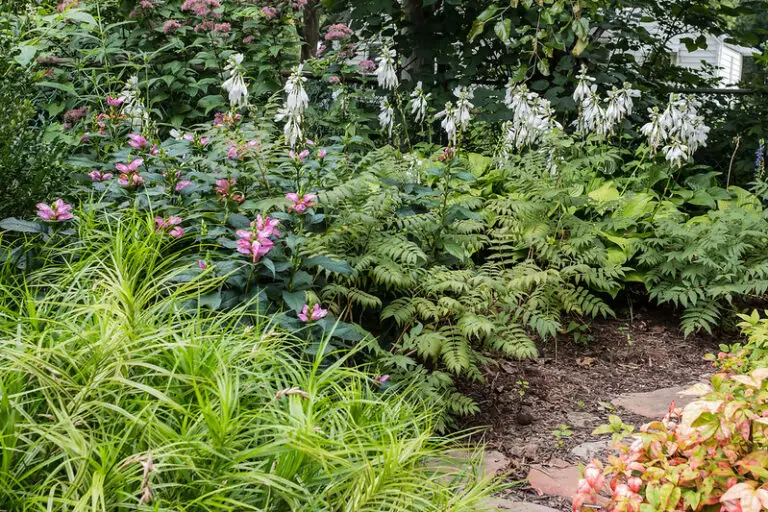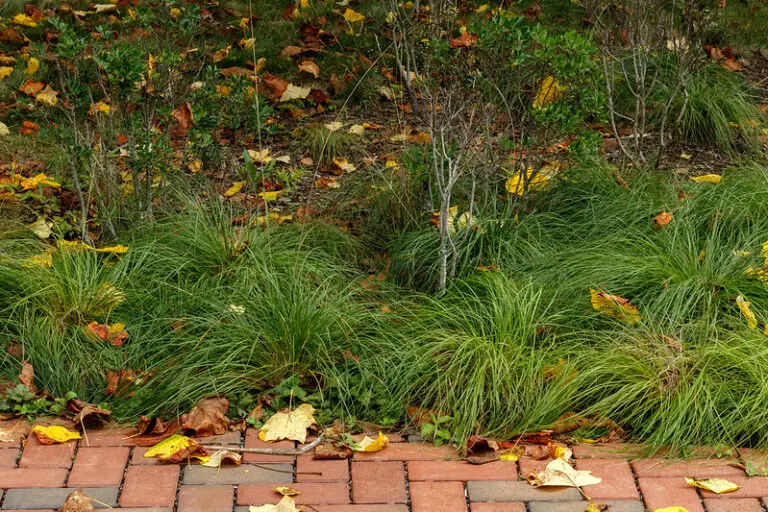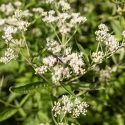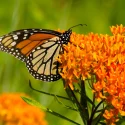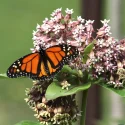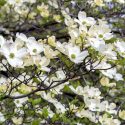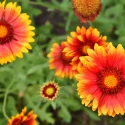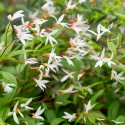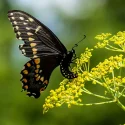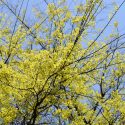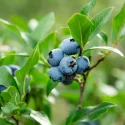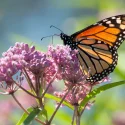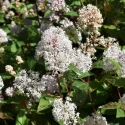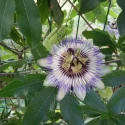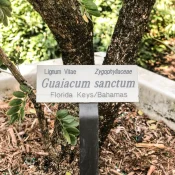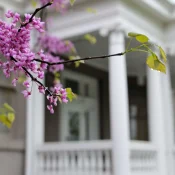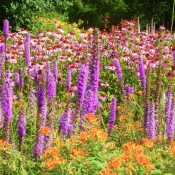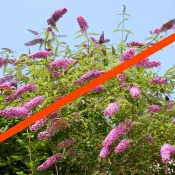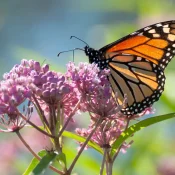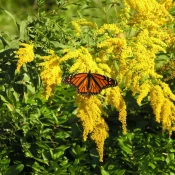Do you have a dry shady area you don’t know what to do with? There’s a sedge for that. Have a wet area you don’t know what to do with? There’s a sedge for that too. Learn about these lush-looking, versatile native plants and how they can fill problem spots in your yard—while adding benefits for native wildlife.
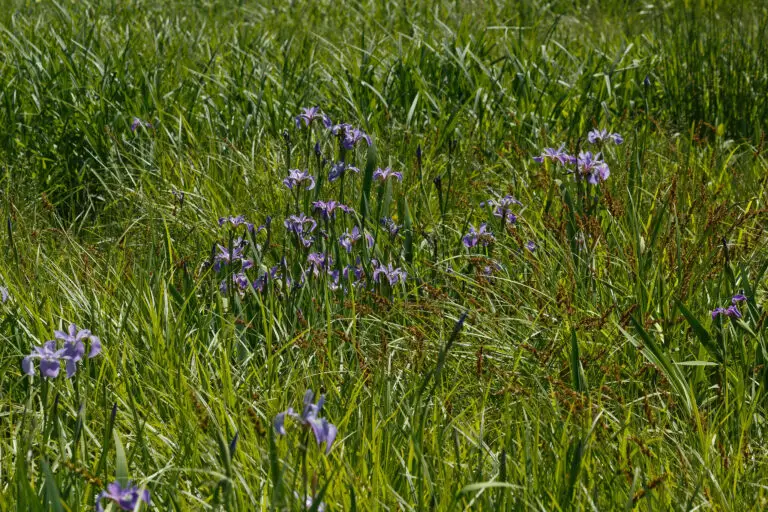
What are sedges?
Sure, everyone knows what flowers and grasses are—but what is a sedge?
Sedges are grass-like plants with many uses in the garden and in the ecosystem. They are in a slightly different family from grasses. The usual rule of thumb to tell them apart is to look at the stems:
- Sedge stems are triangular rather than flat.
They are widespread in North America and are important parts of native ecosystems. We have hundreds of species of them.
In the garden, sedges are a lot like grasses, but they are useful because they can handle different conditions that are tough for other plants, like wet soil or shade. They also bloom with what look like tiny wheat stalks.
Most of them form a clump and don’t spread, so they can be placed in borders or close together to make a meadow-like appearance. Some can even be mown.
Sedges can add color and texture, stability, and lushness to gardens, and fill out spaces that are difficult for other plants to thrive. After they’re established, they’re extremely low-maintenance and fuss-free.
Many are evergreen, too, and they are generally uninteresting to deer and rabbits.
What are the benefits of sedges to wildlife?
Sedges play many important roles in native ecosystems. Many of them are host plants to native butterflies and pollinators, meaning these species need them to lay their eggs on or for their caterpillars to eat.
Birds and other wildlife also eat tiny sedge seeds, and the foliage provides cover for birds and other animals to nest in.
Many sedges are found in wetlands, where they anchor the soil, clean and cool down the water, and provide habitat for fish and other aquatic species. Much like grasses, much of the plant is actually underground, which makes them excellent at stabilizing soil. In some narrow streams, the roots of sedges may reach all the way underneath the water—knitting the two banks together.
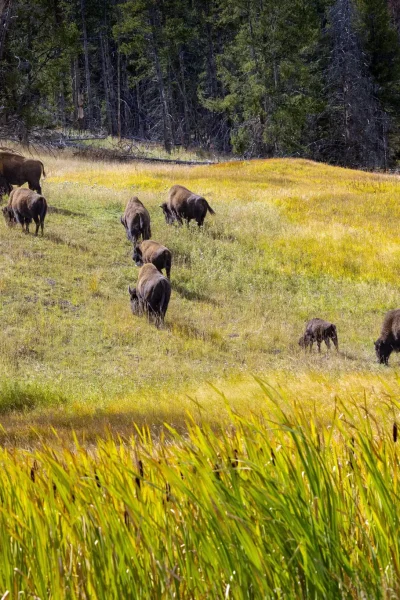
Who eats sedges?
In Yellowstone National Park, scientists have catalogued that almost a third of a bison’s diet is sedges. They are also known to be eaten by beavers, muskrats, pikas, bears, bighorn sheep, musk oxen, moose, elk, and reindeer.
In the wild, sedges are also some of the first species to regrow after forest fires, coming back from underground rhizomes or sprouting from seeds, and they can help prevent soil erosion after a fire.
If you plant sedges in your garden, you are absolutely benefitting native wildlife and ecosystems!
How do I grow sedges?
If you’ve got them in the right spot, sedges are just about the easiest thing to grow. Match your shade and wetness situation to a sedge, using the list below, and you are in for years of low or zero-maintenance green.
Give them a little extra TLC during the first year
You’ll want to baby them a little when they are first planted. But after they are established, sedges don’t need watering, fertilizing, or fussing. If you feel like it, you can give them a haircut once a year in early spring, just about when the new growth starts to be visible.
But you don’t even need to do that. Sedges will just do their thing. (Check out our manifesto on how much easier native gardening is than fussing over a lawn.)
What should I do with sedges?
Much like native grasses, sedges are not always the first thing your eye goes to at the garden center, but they can be incredibly valuable in the garden.
Here are a few ideas for where to plant sedges:
- Fill out spaces where it’s hard for other species to thrive, like dry shade or wet areas.
- Use them to replace part (or all) of your lawn.
- Plant evergreen species for a touch of green in the winter.
- Use them to fill out and add fine texture to a flower bed, or as a neutral repeating element to bring cohesion to your garden.
- Line the edges of pathways for a soft, inviting look.
- Use as a groundcover or to suppress weeds.
- Surround a tree with sedges and add spring bulbs or native spring flowers for a lush look.
- Sedges are nice additions to shade gardens, cottage gardens in partial shade or wet soil, or Prairie-style minimalist gardens.
- Plant wet-loving sedges into your rain garden.
- Plant dry-tolerant sedges in containers to show off their elegant fountain structure.
What are good native sedges for the garden?
Sedges have two main niches in the garden: dry shade areas, or wet areas (in either sun or shade). We’ll go through both categories, as well as some flexible sedges that can handle both.
Sedges for wet areas
Fox Sedge
Native to a huge range of North America, Fox Sedge is a superstar for the garden with moist to wet soils. It forms a 2-foot by 2-foot globe of finely textured, bright green leaves that look lovely as a backdrop to flowers or draping along the edges of a path. Some people have also reported growing it successfully in drier soils in cool climates.
Fox Sedge likes full sun to part shade, but doesn’t like deep shade. If it’s happy and is allowed to spread, it will.
Cherokee Sedge
The sedge for the Southeast, Cherokee Sedge is an upright plant with pleasing electric green strands. This tough plant doesn’t mind clay, heat, or constantly wet soil, and it can handle anything from full sun to shade as long as it’s mostly moist.
Cherokee Sedge will very slowly spread over time, so it can be either used in a garden border or edging along a walkway, or en masse as a groundcover or erosion control. It’s also a great candidate for rain gardens.
Overview
- Latin name: Carex cherokeensis
- 1 foot tall
- Full sun to full shade
- Zones 6-9
- See native range
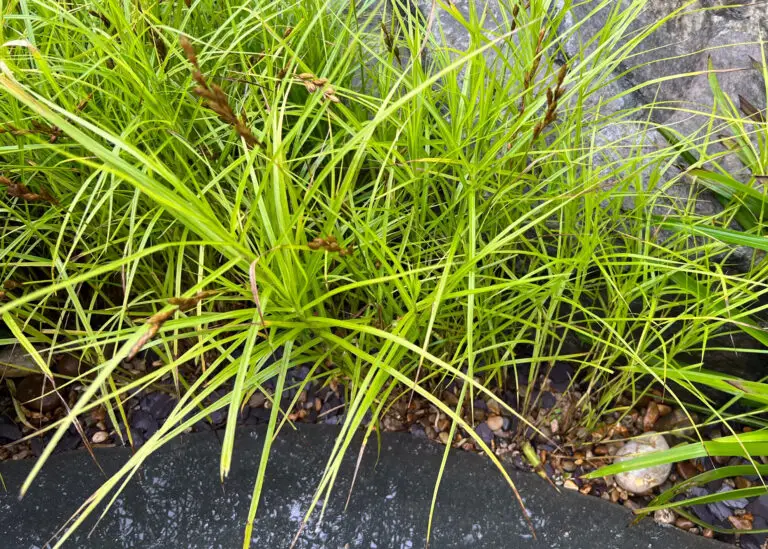
Palm Sedge
Palm Sedge is an unusual sedge with leaves that grow sideways out along the stem in a way that looks a bit like a palm frond. Native to much of the East and Midwest, it adds a nice texture to any wet area, including shallow standing water. If it’s happy, it will spread.
Overview
- Latin name: Carex muskingumensis
- 1-2 feet tall
- Full sun to full shade
- Zones 4-9
- See native range
Sedges for dry areas
Fuss-free options for drier areas.
Ivory Sedge
Prairie Nursery writes, “The soft, spherical appearance of this sedge belies its tough nature and adaptability to heat and drought.” Growing only 6 inches high, this little bright green sedge can survive in anything from full sun to full shade and doesn’t mind sandy or rocky soils. It is native to much of the East, Midwest, and northern Great Plains/Mountain West.
It is a great candidate for planting under trees, in flower beds or rock gardens, or anywhere you need a groundcover in a drier shady spot.
Overview
- Latin name: Carex eburnea
- Less than 1 foot tall
- Full sun to full shade
- Zones 2-8
- See native range
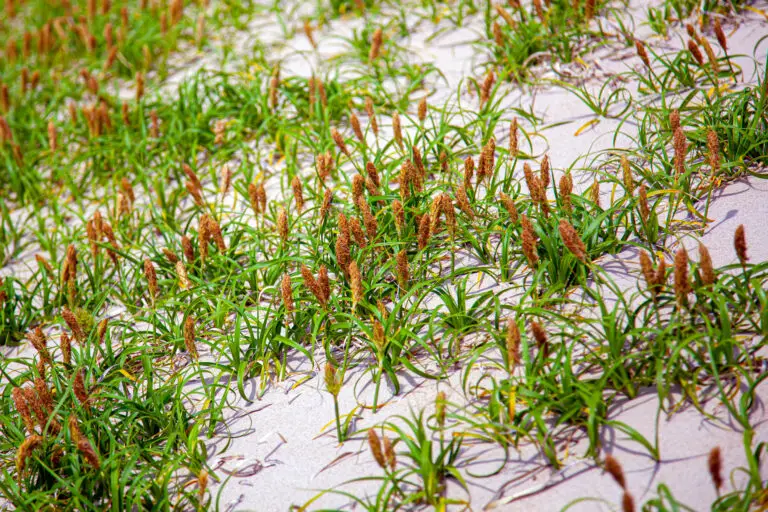
California Meadow Sedge (a.k.a. Sand Dune Sedge).
California Meadow Sedge likes sandy soils and will form a dense low mat that looks pretty darn similar to lawn—while creating a home for small birds, and supporting native butterflies and moths. It is native all along the Pacific Coast.
If you want it to stay green all through summer in a drought, however, it will need some occasional watering (though less than a traditional European lawn). It will stay at about 4” tall and doesn’t need to be mowed.
Overview
- Latin name: Carex pansa
- Less than 1 foot tall
- Full sun to part shade
- Zones 7-10
- See native range
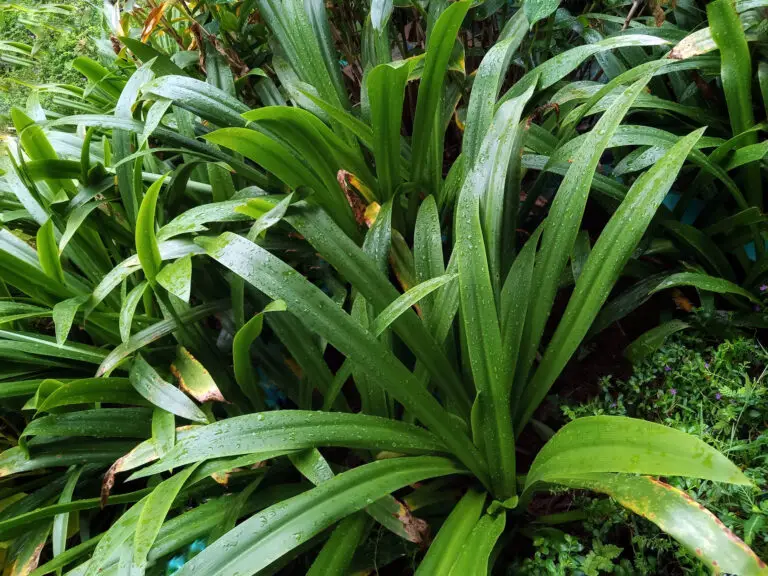
Plantain-leaf Sedge or Silver Sedge
With wide, glossy green leaves that have a pleated look, Plantain-leaf Sedge is a very pretty sedge that looks a bit like a thin-leafed hosta or liriope. It is sometimes also called Seersucker Sedge.
It’s a shade-lover and can handle dry or medium soil. It looks wonderful paired with Wild Ginger as a textural contrast for a native shady groundcover. Plantain-leaf Sedge is native to much of the East and Midwest, and is a host plant for several native butterflies.
Its cousin, Silver Sedge, looks just like it but has beautiful deep blue-green leaves instead of emerald green.
Overview
- Latin names: Carex plantaginea or Carex platyphylla
- Less than 1 foot tall
- Part sun to shade
- Zones 3-8
- See native range
Adaptable sedges that can do both
A few sedges can adapt to many different kinds of situations, which makes them especially useful in the garden (for example, if you want to achieve a unified look across different areas).
Appalachian Sedge
The leaves of Appalachian Sedge are bright green in the spring and summer and turn orange-yellow in fall. “The foliage is wonderfully impressionistic and flowing,” writes William Cullina. This sedge can grow in anything from moist to dry soil and looks nice mixed with flowers in a sunny or part-shade border.
Overview
- Latin name: Carex appalachica
- 1 foot tall
- Sun to part shade
- Zones 4-8
- See native range
Pennsylvania Sedge
Native to much of the eastern U.S., Pennsylvania Sedge is increasingly becoming a darling of gardeners because it can handle that most challenging of garden conditions: the dreaded dry shade. (It can also grow in full blazing sun, but it would prefer for the soil to not be super dry in that case.) Pennsylvania Sedge will form a lovely low, lush look under trees or in partly shaded borders.
It grows to 8 inches tall in a clump, so depending on the look you’re going for, you can leave it alone or mow it to 3 or 4 inches tall a few times a year to form a lawn substitute that can handle light foot traffic.
It is semi-evergreen, especially in milder climates, and will slowly spread, but is not aggressive.
Overview
- Latin name: Carex pensylvanica
- Part sun to full shade
- Less than 1 foot tall
- Zones 3-8
- See native range
Wood’s Sedge (a.k.a. Pretty Sedge)
The nonprofit Mt. Cuba Center ran a trial of native sedges in the garden and Wood’s Sedge took top marks in almost all categories. This Eastern and Midwest native sedge grows best in shade, but also does well in full sun. It’s great at suppressing weeds and can even be considered as a lawn substitute, as it responds well to mowing. It’s semi-evergreen.
Overview
- Latin name: Carex woodii
- 1 foot tall
- Full sun to full shade
- Zones 4-8
- See native range
Long Beaked Sedge
Long Beaked Sedge has a lovely arching habit and looks beautiful around the bases of trees or mixed with flowers. It’s very flexible—it can grow in any kind of soil, including clay; in any moisture level from dry to wet; and in anything from shade to sun. This one likes it cool; it is native to a large swath of the northern U.S.
Overview
- Latin name: Carex sprengelii
- 2 feet tall
- Part sun to full shade
- Zones 3-5
- See native range
I’ve seen the Latin word ‘carex’ repeated; what does it mean?
‘Carex’ is a botanical Latin name inspired by the Greek word keiró, which means to shear or cut hair. The sharp, triangular shape of carex blades inspired this name.
Who comes up with botanical Latin names? For hundreds of years, botanists and scientists did. Now, the International Botanical Congress decides on many things, including Latin plant names. Visit our Do I have to learn Latin? article for more.
You probably have some questions now that we’ve introduced these stellar sedge ideas. Let’s dig in!
Sedge FAQs
What are good native sedges for dry shade?
For dry shade, try Pennsylvania Sedge, Wood’s Sedge, Ivory Sedge, and/or Curly Wood Sedge.
What are native sedges for wet areas?
If your area is sunny and wet, try Fox Sedge, Cherokee Sedge, or Palm Sedge. If it’s shady and wet, try Cherokee Sedge or Palm Sedge.
What are native sedges that are good groundcovers?
Some types of sedges spread and make good groundcovers that can suppress weeds. For the East & Midwest, try Pennsylvania Sedge or Wood’s Sedge in drier soils, or in wet areas, try Cherokee Sedge or Palm Sedge. In California, try California Meadow Sedge in the sun, or look into Short Stem Sedge for the shade; in the Pacific Northwest, look into Dense Sedge.
For all groundcovers, usually you can plant them a foot apart and they will fill in.
Can I replace my lawn with native sedges?
Yes—as long as you match your sedge to the conditions you have, and don’t need it to withstand constant heavy foot traffic. Sedges will make a lovely meadow that is 6-8 inches high, or you can mow it a few times a year to 3 or 4 inches, depending on the kind you choose.
What are sedges that can be lawn replacements?
In the West, try California Meadow Sedge. In the Plains and Texas, try Texas Sedge. In the East, try Pennsylvania Sedge, Wood’s Sedge, or Ivory Sedge for medium to dry soils, or Fox Sedge for wet areas. Remember these sedges can all handle light foot traffic, but not constant use. Mow them high (3 to 4 inches).
How do I find native sedges for sale?
It’s true that it can be harder to find native plants than their non-native counterparts, but it’s getting better all the time. We’ve compiled some resources to help:
Where can I find seeds and plants?
Finding native plants can be challenging (we partly blame Marie Antoinette.) To make it easier, we’ve assembled four sourcing ideas.
300+ native nurseries make finding one a breeze
Explore 100+ native-friendly eCommerce sites
Every state and province has a native plant society; find yours
Online Communities
Local Facebook groups are a great plant source
Sedges can be weirdly difficult to start from seed, so we recommend buying them as plants.
We hope this has helped you learn about a few of our highly useful native sedges here in the U.S. Sedges are just about as low-maintenance a plant as you could ask for—just match your conditions with a sedge and you’re golden.
If you’d like to find more species of sedges for the East, we highly recommend Mt. Cuba Center’s trial of different native sedges. For more absolutely fuss-free plants, check out our beginner’s guide to native grasses. Or learn about how to plant a native rain garden. Happy planting!
Sources
- U.S. Department of Agriculture Forest Services, Carex geyeri (for fire ecology)
- U.S. Department of Agriculture Natural Resources Conservation Service, “SLOUGH SEDGE.” (for ecology)
- Native Meadowscapes, “8 Native Sedges for Any Garden”
- Mt. Cuba Center, Carex for the Mid-Atlantic Region
- North Carolina Extension, Carex plantaginea (Broad-leafed Sedge, Plantain-leafed Sedge, Sedges, Seersucker Sedge)
- North Carolina Extension, Carex cherokeensis (Cherokee Sedge, Sedges)
- Missouri Botanical Garden, Carex muskingumensis
- Missouri Botanical Garden, Carex eburnea
- Prairie Moon Nursery, Carex woodii Wood’s Sedge
- Cullina, William. Native Ferns, Moss, & Grasses: From Emerald Carpet to Amber Wave, Serene and Sensuous Plants for the Garden. Echo Point Books and Media, 2008.
- Wilson, Brainerd, Lytjen, Newhouse, and Otting, Field Guide to the Sedges of the Pacific Northwest. Oregon State University Press, Second Edition.
- Hoadley, Sam. “6 Native Sedges for the Garden.” Fine Gardening, Issue 220.
What if your feed was actually good for your mental health?
Give your algorithm a breath of fresh air and follow us.
